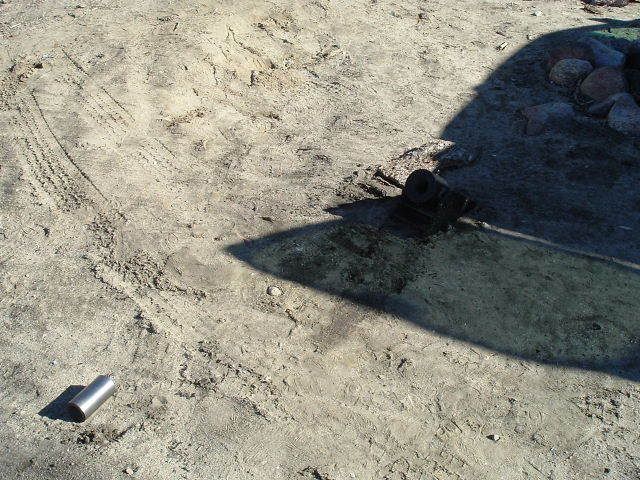A thread down below, where the use of wet paper wadding is being discussed got me thinking...
I wonder how the safety (as related to pressure) of projectile/wad materials that are sometimes used in cannons/mortars can be determined?
The ideal condition in any cannon or mortar would be that there is NO possibility that a projectile and/or wad would be able to expand upon firing to the point where it is constrained in the bore tightly enough (or long enough) for a dangerous level of pressure to build.
In particular, I'm thinking of what might happen to a golf ball in a long cannon barrel with a 'standard' charge and 'correct' windage (if those parameters have been defined conclusively somewhere).
Some may remember that I had Dom make my soda can Dictator mortar with a reduced diameter bore sleeve (1.72" diameter) that could be used to fire golf balls (1.68"). Upon firing with the unrestrained golf ball sleeve, the sleeve was ejected from the barrel. I believe that this was due to deformation of the golf ball diameter upon firing, causing it to grab onto the sleeve (Note that Dom made the bbl sleeve to my design - I thought it would stay in place on its own. I plan to add a retaining feature in the future)....

Hefty blank charges with an alum foil wad rammed on top do not cause the sleeve to move.
So... What of a golf ball in a cannon-length tube with the same windage as my mortar? Is there cause for concern that the ball may stick in the barrel and cause a dangerous pressure spike?
What about other combinations of wads/projectiles?
It seems that there have been several projectile/wad combinations discussed here that might have a potential to deform and cause higher than average pressures beyond what a wad of wet newspaper might:
1. A canvas patched ball in a large mortar.
2. A soda can full of ice or Plaster of Paris.
3. A wad of aluminum foil between ball and charge in a 1" cannon.
On a related note, I have a personal experience to share...
Many years ago I shot a long (~three calibers) 3" diameter solid Delrin (plastic) rod out of my 3.125" bore Coehorn mortar using 2 oz of Fg. It was on a sled type base with 2" thick pine side rails. The bbl was set at ~45 degrees. I had no idea that such a projectile might be dangerous at the time.
The shot was very loud and the plastic rod, which I figured would go a few hundred yards, went out of sight. In about two seconds it was just a speck in the sky, off into the desert past what I could estimate in distance. The barrel swung back about 90 degrees from where it was at firing and slammed into the rear cross-member, and one side rail was split top to bottom. This had never happened even when firing 3" lead balls.
I believe that the plastic rod deformed upon firing and sealed the bore until enough pressure built up to force it out of the bore. Fortunately, the barrel was heavy-walled 4130 and not cast iron.
Anyway, be aware of the safety of what you place ON TOP of the powder, not just the charge itself.